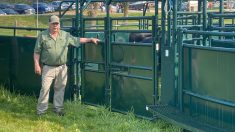The Woolmark Company has a new plan to promote the sustainability of wool.
“There’s wool for all seasons,” said Monica Ebert, sustainability manager for the Australian-based company. “You just have to find the right pieces.”
Why it matters: IT MATTERS: The Canadian wool industry believes it could benefit from strategies similar to those used by Australia.
Read Also

Dissolving eartags could make pig traceability easier
A dissolving eartag for market hogs, called Clean Trace could reduce processing challenges and enable more individual management of pigs.
Ebert was the guest speaker during a Campaign for Wool “Spinning Yarn” webinar series last month. She believes the wool industry has been so focused on carbon that it missed opportunities to highlight the positive benefits of growing wool and raising sheep on the landscape.
Matthew Rowe, chief executive officer of Campaign for Wool in Canada/Canadian Wool Council, said Canada should look to Australia’s success.
Australia has a unique perspective on the wool industry and is a significant source of global fashion wool. Ninety per cent of wool bales will be traced back to Australia by 2025, he said.
Wool accounts for one per cent of global fibre production by volume and eight per cent by value but is still losing ground to synthetics, which fuel fast fashion despite the natural fibre’s superior quality and eco-friendly life cycle.
Woolmark released “Wear Wool, Not Waste,” a cinematic, apocalyptic clothing-zombie commercial encouraging consumers to re-evaluate fibre choices. The commercial highlighted the long-term impact of fossil fuel-derived products compared to the versatility, biodegradability, recyclability and long-lasting characteristics of wool materials.
“The work they do is so important for branding the fibre writ at large, and it helps to lift smaller industries, like ourselves, with all the research they invest in, the testing and the marketing,” said Rowe.
“That gives us a leg up in terms of being able to get our message out to consumers. Having an organization like Woolmark at the forefront is so important to achieve that.”
Woolmark launched the Nature Positive road map with 13 initiatives that fall under three categories:
- Accelerating nature-positive production;
- Delivering the circular fibre of choice; and
- Supporting thriving flocks and communities.
“We need to be looking beyond net zero and moving towards nature positive. And that means getting outside of a carbon tunnel vision,” said Ebert.
Nature-positive initiatives focus on halting and reversing nature loss in Australia by 2030, measured from a 2020 baseline, optimized for biodiversity recovery, livelihood benefits and carbon sequestration.
“Wool growers are already doing so much,” Ebert said. “We just want to make sure that’s heard and that brands and consumers understand that.”
Key initiatives include developing science-based, practical metrics for assessing and reporting wool growers’ environmental outcomes, including emission reductions, on-farm certification schemes and brands that can prove environmental claims.
Australia is the biggest wool producer globally, followed by China, New Zealand and Turkey. Seventy-three per cent of Australia’s wool producers are already undertaking measures to maintain, enhance or track biodiversity on their properties.













